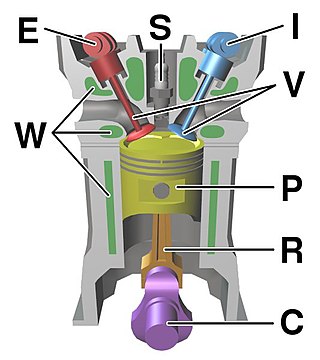
The compression ratio is the ratio between the maximum and minimum volume during the compression stage of the power cycle in a piston or Wankel engine.

The Diesel cycle is a combustion process of a reciprocating internal combustion engine. In it, fuel is ignited by heat generated during the compression of air in the combustion chamber, into which fuel is then injected. This is in contrast to igniting the fuel-air mixture with a spark plug as in the Otto cycle (four-stroke/petrol) engine. Diesel engines are used in aircraft, automobiles, power generation, diesel–electric locomotives, and both surface ships and submarines.

In engineering, the Miller cycle is a thermodynamic cycle used in a type of internal combustion engine. The Miller cycle was patented by Ralph Miller, an American engineer, U.S. patent 2,817,322 dated Dec 24, 1957. The engine may be two- or four-stroke and may be run on diesel fuel, gases, or dual fuel. It uses a supercharger or a turbocharger to offset the performance loss of the Atkinson cycle.
A stratified charge engine describes a certain type of internal combustion engine, usually spark ignition (SI) engine that can be used in trucks, automobiles, portable and stationary equipment. The term "stratified charge" refers to the working fluids and fuel vapors entering the cylinder. Usually the fuel is injected into the cylinder or enters as a fuel rich vapor where a spark or other means are used to initiate ignition where the fuel rich zone interacts with the air to promote complete combustion. A stratified charge can allow for slightly higher compression ratios without "knock," and leaner air/fuel ratio than in conventional internal combustion engines.

A four-strokeengine is an internal combustion (IC) engine in which the piston completes four separate strokes while turning the crankshaft. A stroke refers to the full travel of the piston along the cylinder, in either direction. The four separate strokes are termed:
- Intake: Also known as induction or suction. This stroke of the piston begins at top dead center (T.D.C.) and ends at bottom dead center (B.D.C.). In this stroke the intake valve must be in the open position while the piston pulls an air-fuel mixture into the cylinder by producing a partial vacuum in the cylinder through its downward motion.
- Compression: This stroke begins at B.D.C, or just at the end of the suction stroke, and ends at T.D.C. In this stroke the piston compresses the air-fuel mixture in preparation for ignition during the power stroke (below). Both the intake and exhaust valves are closed during this stage.
- Combustion: Also known as power or ignition. This is the start of the second revolution of the four stroke cycle. At this point the crankshaft has completed a full 360 degree revolution. While the piston is at T.D.C. the compressed air-fuel mixture is ignited by a spark plug or by heat generated by high compression, forcefully returning the piston to B.D.C. This stroke produces mechanical work from the engine to turn the crankshaft.
- Exhaust: Also known as outlet. During the exhaust stroke, the piston, once again, returns from B.D.C. to T.D.C. while the exhaust valve is open. This action expels the spent air-fuel mixture through the exhaust port.
Pre-ignition in a spark-ignition engine is a technically different phenomenon from engine knocking, and describes the event wherein the air/fuel mixture in the cylinder ignites before the spark plug fires. Pre-ignition is initiated by an ignition source other than the spark, such as hot spots in the combustion chamber, a spark plug that runs too hot for the application, or carbonaceous deposits in the combustion chamber heated to incandescence by previous engine combustion events.
Lean-burn refers to the burning of fuel with an excess of air in an internal combustion engine. In lean-burn engines the air–fuel ratio may be as lean as 65:1. The air / fuel ratio needed to stoichiometrically combust gasoline, by contrast, is 14.64:1. The excess of air in a lean-burn engine emits far less hydrocarbons. High air–fuel ratios can also be used to reduce losses caused by other engine power management systems such as throttling losses.
Dieseling or engine run-on is a condition that can occur in spark-plug-ignited, gasoline-powered internal combustion engines, whereby the engine keeps running for a short period after being turned off, drawing fuel through the carburetor, into the engine and igniting it without a spark.
Homogeneous charge compression ignition (HCCI) is a form of internal combustion in which well-mixed fuel and oxidizer are compressed to the point of auto-ignition. As in other forms of combustion, this exothermic reaction produces heat that can be transformed into work in a heat engine.
Variable compression ratio (VCR) is a technology to adjust the compression ratio of an internal combustion engine while the engine is in operation. This is done to increase fuel efficiency while under varying loads. Variable compression engines allow the volume above the piston at top dead centre to be changed. Higher loads require lower ratios to increase power, while lower loads need higher ratios to increase efficiency, i.e. to lower fuel consumption. For automotive use this needs to be done as the engine is running in response to the load and driving demands. The 2019 Infiniti QX50 is the first commercially available vehicle that uses a variable compression ratio engine.

The hot-bulb engine, also known as a semi-diesel or Akroyd engine, is a type of internal combustion engine in which fuel ignites by coming in contact with a red-hot metal surface inside a bulb, followed by the introduction of air (oxygen) compressed into the hot-bulb chamber by the rising piston. There is some ignition when the fuel is introduced, but it quickly uses up the available oxygen in the bulb. Vigorous ignition takes place only when sufficient oxygen is supplied to the hot-bulb chamber on the compression stroke of the engine.

In a spark ignition internal combustion engine, ignition timing is the timing, relative to the current piston position and crankshaft angle, of the release of a spark in the combustion chamber near the end of the compression stroke.

A model engine is a small internal combustion engine typically used to power a radio-controlled aircraft, radio-controlled car, radio-controlled boat, free flight, control line aircraft, or ground-running tether car model.
Glow fuel is a fuel source used in model engines – generally the same or similar fuels can be used in model airplanes, helicopters, cars and boats. Glow fuel can be burned by very simple two-stroke engines or by more complicated four-stroke engines, and these engines can provide impressive amounts of power for their very small size. Glow fuel is primarily for two-stroke engines with the need for oil mixed in the fuel and limited exhaust and fuel/air between cycles. Top Fuel race cars with 4-stroke engines may also use glow fuel, but in this case it does not contain appreciable oil.

A glow plug engine, or glow engine, is a type of small internal combustion engine typically used in model aircraft, model cars and similar applications. The ignition is accomplished by a combination of heating from compression, heating from a glow plug and the catalytic effect of the platinum within the glow plug on the methanol within the fuel.
Diesel engine runaway is an occurrence in diesel engines, in which the engine draws extra fuel from an unintended source and overspeeds at higher and higher RPM, producing up to ten times the engine's rated output until destroyed by mechanical failure or bearing seizure due to a lack of lubrication. Hot-bulb engines and jet engines can also run away via the same process.

The Hesselman engine is a hybrid between a petrol engine and a diesel engine. It was designed and introduced in 1925 by Swedish engineer Jonas Hesselman.
Internal combustion engines come in a wide variety of types, but have certain family resemblances, and thus share many common types of components.

A cold start is an attempt to start a vehicle's engine when ambient temperatures are much lower than its normal operating temperature. A cold start can be difficult for an engine due to higher viscosity of oil and fuel in cold temperatures.

An internal combustion engine is a heat engine in which the combustion of a fuel occurs with an oxidizer in a combustion chamber that is an integral part of the working fluid flow circuit. In an internal combustion engine, the expansion of the high-temperature and high-pressure gases produced by combustion applies direct force to some component of the engine. The force is typically applied to pistons, turbine blades, a rotor, or a nozzle. This force moves the component over a distance. This process transforms chemical energy into kinetic energy which is used to propel, move or power whatever the engine is attached to.









